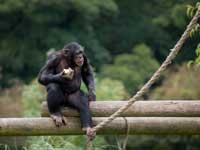Are we what we eat?

Children are born sterile and then begin to collect bacteria from their mother. These microbes multiply and fill the intestines; in the belly of an adult they can live a thousand species. The truth is that so far it has not been clear what affects the composition of this community. That is, what kind of bacteria are in our intestine and in what quantity? And why?
This composition may depend on what we receive from our mothers, but also on what we eat or some other factor. So far there has been a debate on the supposed cause of the internal variations of microbial communities, which many argue that the most decisive factors are precisely diet and habitat.

Scientists have been using new genetic techniques for years to try to find out if different animal species have different microbial communities. Some previous studies suggest that animals with a similar diet usually have similar microbial communities. However, members of the University of Yale (USA) have recently found that the diversity of the composition of intestinal communities is highly conditioned by the species of its host.
Evolutionary relationship also in our intestines
In order to check whether the key is food, Yale researchers have analyzed 26 stool samples, all of them collected in the natural habitat of animals: three subspecies of chimpanzees, two species of gorillas and excrements of two human beings, one from Arizona and one from the African Central Republic.

They sequenced the DNA of the bacteria in each sample and focused on a specific gene, whose sequence varies from one species to another. In the samples corresponding to primates it was observed that in their intestine there were different types of bacteria and that the number of bacteria of each type was different. With this data, the researchers created the tree corresponding to the bacterial relationships between primates; they established together primates with the same type and quantity of intestinal bacteria and vice versa.
To the surprise of the researchers, they saw that the tree coincided with the evolutionary relationship of primates: the bacteria found in the human intestine, for example, are more similar to those of the two subspecies of chimpanzees than to those of gorillas. They consider that food is probably not a determining factor, since the two human beings analyzed shared intestinal bacteria, although they belonged to two different zones of the world.
“Bacteria are really important to human health. They improve the immune system, protect us from toxins and contribute to the process of maturation and renewal of intestinal cells, said one of the responsible of the study. The number of intestinal microbes is ten times higher than that of our cells. The truth is that we didn’t know exactly how and why they reach our belly.”
The results of the study can give some light to this question. “Observing the intestinal composition it is possible to separate chimpanzees from humans. The novelty is that intestinal microbes have followed the evolution of their guests for millions of years.”
Published in 7K.
Buletina
Bidali zure helbide elektronikoa eta jaso asteroko buletina zure sarrera-ontzian











